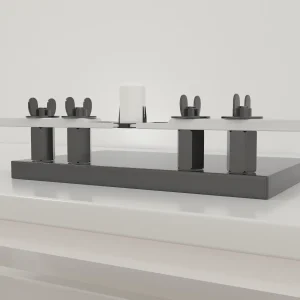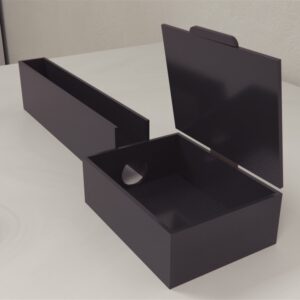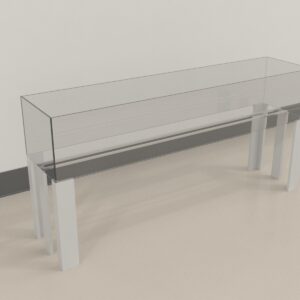$1,790.00 – $1,890.00
The Pawedness Trait Test (PaTRaT) is a behavioral assessment tool designed to measure the degree of paw preference in rodents and its connection to neural functions such as motor activity, cognition, impulsivity, and memory. The PaTRaT setup utilizes a preference-based approach, allowing the subject to freely use either paw to manipulate a food reward during the experiment. The tendency to favor the right or left paw is associated with asymmetry in monoamine levels and dopaminergic activity in the brain (Barnéoud, Moal, & Neveu, 1990).
MazeEngineers offers the PaTRaT in versions tailored for both mice and rats.

MazeEngineers offers custom-built behavioral mazes at no extra cost—designed to fit your exact research needs. Eliminate reproducibility issues from poor sizing or lingering scent cues with precision-engineered, modular, and smart mazes that adapt in real time to animal behavior. Publish new protocols, run adaptive experiments, and push the boundaries of behavioral science.



Mouse Features |
Height of Cage: 26 cm |
Diameter of Cage: 12.0 cm |
Grid opening: 0.75 cm x 1.5 cm |
Receptacle Height: 2.5 cm |
Rat Features |
Height of Cage: 40 cm |
Diameter of Cage: 17.5 cm |
Grid opening: 1.1 cm x 2.2 cm |
Receptacle Height: 4 cm |

Compared to earlier assessments like the Collins and Lateral Paw Preference tests, the Pawedness Trait Test (PaTRaT) enhances subject motivation to engage in the task. While traditional tests focus solely on exclusive use of the left or right paw, PaTRaT not only measures this but also quantifies potential intermediate movements. The intermediate pawedness observed in rats using the PaTRaT provides results more akin to human handedness. The test evaluates the preferential use of the right or left paw through an advanced classification system.
The PaTRaT apparatus features a circular grid that separates the rodents from the food rewards. The mesh size is smaller than the reward, compelling the subject to use a variety of dexterous movements to retrieve the food. Other tools used for examining motor activity and coordination in rodents include the Skilled Forelimb Test, Stairway Test, Static Rods Test, and Grid Test.
The Pawedness Trait Test apparatus is composed of an open-top plexiglass box. At the center, a 40 cm long wire mesh cylinder is positioned to enclose the subjects, with a diameter of 17.5 cm. The grid holes in the mesh measure 1.1 cm by 2.2 cm. Attached to the outside base of the cylinder is a reward holder, measuring 4 cm in height and 2 cm in width. The entire setup is mounted on a supporting platform that measures 50 cm by 75 cm.
Clean all apparatus and equipment thoroughly before and after trials with 10% ethanol. Conduct the experiment in a controlled environment. An external tracking and recording systems such as the Noldus Ethovision XT can be used to record the subject’s behavior.
The following observations can be made using the Pawedness Trait Test:
Pawedness in the Pawedness Trait Test is classified on a scale of +4 to -4 where the positive and the negative values reflect the preference of left or right paw respectively. The values on the scale are reflective of the increasing preference of the paw as shown below:
Rating | Interpretation |
0 | Absence of exclusive paw preference and final withdrawal with the mouth |
1 | Handling with both paws and final withdrawal with either left or right paw |
2 | Handling with one paw but retrieval with the other paw |
3 | Exclusive usage of preferred paw followed by withdrawal with the mouth or almost exclusive usage of the preferred paw |
4 | Exclusive usage of the preferred paw |
Barnéoud, P., Moal, M. A., & Neveu, P. J. (1990). Asymmetric distribution of brain monoamines in left- and right-handed mice. Brain Research, 520 (1-2), 317-321. doi:1016/00068993(90) 91721-R
Cunha, A. M., Esteves, M., Neves, S., Borges, S., Guimarães, M. R., Sousa, N., Leite-Almeida, H. (2017). Pawedness Trait Test (PaTRaT)—A new paradigm to evaluate paw preference and dexterity in rats. Frontiers in Behavioral Neuroscience, 11(192), 1-9. doi: 10.3389/fnbeh.2017.00192
| Species | Mouse, Rat |
|---|
There are no questions yet. Be the first to ask a question about this product.
Monday – Friday
9 AM – 5 PM EST
DISCLAIMER: ConductScience and affiliate products are NOT designed for human consumption, testing, or clinical utilization. They are designed for pre-clinical utilization only. Customers purchasing apparatus for the purposes of scientific research or veterinary care affirm adherence to applicable regulatory bodies for the country in which their research or care is conducted.